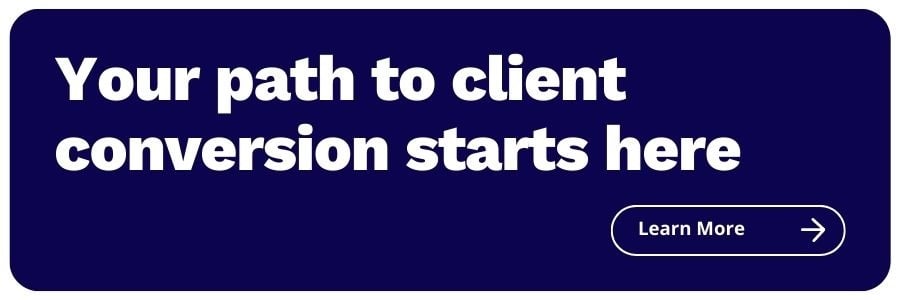How to Create a Successful Blog as an Independent Financial Advisor
Share this
When done right, blogging acts as a powerful marketing tool for financial advisors. It helps you build your brand, attract prospective clients, create credibility, establish yourself as an expert, generate long-term engagement, and more.
But there’s also a reason why not every financial advisor has a blog. Starting a blog is a lot of work and requires time, an incredibly valuable resource many independent financial advisors are short on.
At first, it might feel like a thankless job and at times, you’ll wonder if it’s worth the effort. That’s because as with many other marketing tactics, results are not instantaneous.
But that most certainly doesn’t mean blogging isn’t worth it. A blog is one of the most cost-effective ways to become an authority in the industry and convert intrigue into leads. Through your content, you’ll have countless opportunities to interact with potential clients without spending a dime.
If you’re interested in starting a blog, or refining yours, follow the simple rules below to ensure you’re making the most of your time and getting the most bang for your blog.
Rule #1. Face the Fear
It’s easy to find any number of reasons why you can’t write.
I don’t like writing. I’m really more of a numbers person. I haven’t written in forever.
All of these “reasons” may be true. But they’re also just excuses. There’s no reason why you can’t write, no matter how unqualified you think you are for the task.
Just as a lot of people are afraid of public speaking, a lot of people are also afraid of writing. They’re afraid of sounding dumb or inexperienced. But the most beneficial thing you can do to become a better writer is really quite simple: start writing.
That’s right. The best way to improve your writing is to actually start, and then keep, writing.
For many people, though, getting started is the hardest part. Staring at a blank screen can be incredibly intimidating, and writer’s block often sets in.
But consider this: no other profession accommodates “block” as an excuse to not work. You can’t show up to your job and say you have “worker’s block” and expect to be met with anything other than laughter.
Writers therefore should not accept writer’s block as a legitimate reason not to write—it’s merely an excuse.
So, if you’re really struggling to get started and worry every word you write sounds ridiculous, remember that it doesn’t matter. Your first draft should never be your final draft. You’re going to revise it many times over.
Putting words to paper—brilliant words, dumb words, literally any words—is the only chance you have to create something valuable.
As you get started, keep in mind that your first draft is not the time for perfectionism nor is it the time for revisions. If you start revising while writing, you’ll quickly lose your momentum and stagnate your production.
The most important thing during this initial stage is getting your thoughts down on paper, no matter how erratic.
If you allow yourself to revise as you write, you’ll soon find yourself retooling, rearranging, and agonizing over every word until you’ve entirely lost the momentum you need to transfer your ideas from your head to the paper.
The time for revision will come later; for now, your goal is simply to start.
Rule #2. Be Yourself
Blogging is by no means a best kept secret. Many financial advisors are wise to the power of the blog and have been creating content for years.
That means that many financial topics have already been written about.
However, you still have something to offer that no one else has: your unique voice.
That’s why it is so important to find your own voice and always use it. No matter how good someone else’s voice sounds, don’t try to adopt or emulate it. Many businesses have lost their lives to inauthenticity.
Your voice will allow you to connect to your audience in a genuine way. It will humanize your writing and give your prospects a clear impression of who you are and what it’s like to do business with you.
When your voice is clear and consistent, your audience will hear the same person speaking, which will make your brand more personal and approachable, build your credibility and authority as a financial advisor, and help you stand out.
Rule #3. Write for Your Audience
Your writing should always meet the needs of your audience. Consider the actions you want your audience to take as they consume your content.
This is truly where the battle is lost or won. You could go head-to-head with the strongest writer in the world and if you understand the audience better, you’ll win every time when it comes to connection, engagement, and conversion.
To be able to effectively write for your audience, you of course need to know your audience. You are not your audience. Your content should never be all about you and your firm—that’s what the About and Services pages of your website are for.
When crafting content, think about what problems your clients and prospective clients are facing. What’s keeping them up at night? What financial problems are they struggling to overcome?
Once you’ve identified these pain points, you can create content that offers solutions. Offering solutions to your prospects’ problems in your content will keep them wanting more and will ensure they continue to consume your content.
Rule #4. Have a Purpose
You should never create content simply for the sake of having content. Your content should always have a purpose. Articulate that reason to yourself before you attempt to articulate it to your readers.
Your blog serves a purpose to your prospects and clients, but it also serves a purpose to you. This is where calls-to-action (CTAs) come in. CTAs are a critical component of your website’s lead generation strategy and drive people to convert on your landing pages.
Without a CTA, that blog you labored over is simply a free piece of non-converting content; blog posts without CTAs do not convert readers. When you include CTAs in your blog posts, your blog becomes a place where you can turn traffic into leads.
Encouraging readers to share your content on social media is a simple CTA that also helps increase views and brand awareness. Include social share buttons on your post to allow readers to easily post your content to their social channels.
You can also include a blog subscription CTA on your blog posts. This is a great way to increase your blog subscriber base. Be sure to keep it simple and only ask for the information you need—if you just need an email address, only ask for an email address.
You might also consider including a CTA to download a relevant freemium, or lead magnet (if you have one to offer). Lead magnets are another effective technique for gaining a prospect’s contact information. They are most often in the form of ebooks, templates, checklists, white papers, or other similar downloadable assets.
Rule #5. Be Clear & Concise
All great pieces of content are respectful of their readers’ time; that is to say, they are clear and concise.
Never sacrifice clarity to show off a big vocabulary. Your writing should be relatable, not pretentious. Often, the best words are the simplest words.
Keep paragraphs short and use bullets and numbered lists to break up large blocks of text. To quote a fellow XYPN marketeer, “Walls of text are unAmerican.”
You are creating content to help your prospects and clients. If your content lacks clarity, you won’t be helping anyone, least of all yourself. Content that’s weighed down with unnecessary words becomes a burden to your readers.
Remove everything that’s not part of the story. If the text doesn’t further your readers’ knowledge or understanding, it doesn’t belong. It’s easy to grow attached to every word you write but be ruthless as you cut everything that isn’t necessary.
Consider it a win if a middle schooler can understand your point; the less time your readers have to spend trying to figure out what you’re saying, the better.
Rule #6. Be Consistent
It’s not just what you say that matters—it’s also how you say it. Consistency is key to creating great content. It builds credibility and fosters a strong reputation.
When your language, tone, structure, and branding are consistent, it creates a unified experience, which in turn builds trust with your audience.
Inconsistent content, on the other hand, can confuse your audience and damage your brand.
You should also work to publish content consistently. This will not only help you stay on track and keep the writing wheels turning, but it will also train your readers when to expect new content from you. They’ll begin to look forward to your weekly Wednesday blog post.
Rule #7. Create Evergreen Content
To ensure you’re spending your time wisely, create evergreen content—content that will carry the same value as time passes and will continue to attract traffic well into the future (perhaps even at a higher rate than when it was first published).
Evergreen content is so valuable because it continues to work for you long after you publish it. It guarantees SEO, traffic, and leads over time. It is your workhorse—this content will work for you day in and day out.
Because evergreen content is high quality and timeless, it typically ranks very well in search engines over time. It will therefore be very findable and will continue to generate leads (as long as its appropriately optimized for lead generation).
Maximize the benefits of your evergreen content by linking to other evergreen blog posts and continuing to promote it on your social channels long after it’s first published.
Rule #8. Be Findable
It takes a lot of time and effort to produce purposeful content. That time and effort will be wasted if no one can find it.
Make sure your content is findable online by using the right keywords, crafting a quality meta-description, and being strategic about your H1 and H2 tags.
Customize your metadata, which includes your title, keywords, and description, so it actually describes the content you are publishing.
The meta description tag serves one primary purpose: to describe the page to searchers as they read through search engine results pages (SERPs). This tag doesn’t actually influence ranking, but it will determine whether or not a searcher actually clicks on your result. This is your opportunity to sell your blog post.
Every blog post should have one H1 tag—this is the title of your blog and may also be called a title tag—and multiple H2 tags—these are the sections into which you divide your blog, like the chapters of a book.
Your H1/title tag contains information that’s very important for SEO. It will be displayed on SERPs as the clickable headline for your post, and essentially acts as a first impression. Your H1/title tag should be an accurate and concise description of the content.
Your H2 tags will guide readers to specific sections of your content. These tags give readers an even clearer picture of what your content covers and helps them quickly find the specific information they’re seeking. Be intentional and selective with your H2 tags and use them sparingly. The more H2 tags you use, the less useful they become.
(You can use H3 tags too, but they don’t perform as well in terms of SEO as H1 and H2 tags.)
Include links, especially links to other content you’ve created, to increase the value assigned to your pages. Internal links are a direct signal that your content is important. Google uses links to determine what content on your site is related, and to rank the value of that content. Google crawls websites by following links (both internal and external), and to assign link value. Links therefore pass their link value, or link authority, on.
Include alt tags on any photos and graphics to ensure they appear in image searches. Alt text strengthens the message of your blog and improves findability on search engines. Google places a relatively high value on alt text, which is used to determine what an image actually is and how it relates to the surrounding text. Your alt tags should describe the picture in the image and highlight your content.
Rule #9. Always Revise
No one wants to read a clumsily written article full of mistakes. Poorly written content will reflect poorly on you and your firm, even if the ideas presented are helpful and interesting.
As you work to finalize your piece, ask yourself if the story you are telling makes sense. Does the information presented follow a logical sequence? Is there redundancy, or unnecessary filler? Continue revising your content until you have a cohesive narrative.
Once you’re satisfied with the nature of the content itself, start editing with a detailed eye. Study your text for typos, grammatical errors, and syntactical mistakes. Don’t rely entirely on software to check your spelling and grammar for you; while spell check can be helpful, you cannot trust it blindly.
Rule #10. Just Finish It Already
The scariest part of completing a piece of content is realizing that once it’s published, you can be judged. Don’t let that fear stop you from finishing.
You could spend a lifetime revising any piece of writing. The editing process is an important part of blogging that should never be overlooked, but it’s meant to be finite.
You may very well go through a series of revisions (and you most certainly should!), but eventually, you’ll need to make the conscious decision that your piece of content is good enough for publication and pull the trigger.
A good way to ensure the revision process doesn’t become an infinite task is to set, and actually hold yourself to, a deadline. Author Blake Atwood once said, “Without a deadline, every word you write will feel like you’re building a bridge to nowhere.”
Now that you know the ten rules of effective blogging, you’re ready to put your pen to paper (or rather your fingers to keyboard).
At the end of the day, you can memorize as many writing principles as you want, but the only real way to become a writer is to just write. Do yourself, and your prospective clients, a favor and begin your blogging journey.
The longer you put off writing, the harder it will be to get started.
 About the Author
About the Author
As XYPN’s Content Manager, Kelly Moorman is tasked with communicating the Network's value proposition to the world. For years, Kelly has helped organizations tell their stories in ways that inspire others to listen, and to care. Her penchant for a well-crafted sentence, good grammar, and clever wordplay has earned her the moniker “Word Whiz” around the XYPN office. She’s thrilled to share XYPN’s story with you and the rest of the world.
Share this
- Fee-only advisor (381)
- Advice (305)
- Business Development (248)
- Independent Financial Advisor (203)
- Growing Your Firm (161)
- Marketing (133)
- Financial Planning (129)
- What Would Arlene Say (WWAS) (81)
- Business Coach (80)
- Firm Ownership (78)
- Training (75)
- Compliance (72)
- Business (69)
- Building Your Firm (65)
- Financial Advisors (63)
- Online Marketing (61)
- Events (59)
- Starting a Firm (52)
- Staffing & HR (49)
- Technology (49)
- From XYPN Members (48)
- Launching a firm (46)
- Advisors (41)
- Entrepreneurship (38)
- Taxes (37)
- Networking & Community (33)
- Interviews and Case Studies (32)
- Investment Management (31)
- Sales (27)
- Social Responsibility (27)
- Tax Preparation (27)
- XYPN Invest (26)
- Business Owner (25)
- Small Business Owner (20)
- Financial Management & Investment (19)
- Industry Trends & Insights (19)
- Financial Education (17)
- Financial Planners (17)
- Independent Financial Planner (17)
- Tech Stack (17)
- XYPN (17)
- Leadership & Vision (16)
- Investing (15)
- Niche (15)
- How to be a Financial Advisor (14)
- NextGen (14)
- RIA (14)
- Media (13)
- Preparing to Launch (13)
- Press Mentions (13)
- RIA Operations (12)
- RIA Owner (12)
- XYPN Membership (12)
- Assets Under Management (AUM) (11)
- First Year (11)
- Goals (11)
- Scaling (10)
- Advisor Success (9)
- Building Your Firm (8)
- Communication (8)
- Lessons (8)
- Study Group (8)
- Time Management (8)
- Virtual Advisor (8)
- Behavioral Finance (7)
- Growth (7)
- Pricing Models (7)
- From Our Advisors (6)
- Independent RIA (6)
- Money Management (6)
- Motivation (6)
- Processes (6)
- Automation (5)
- Broker-Dealers (5)
- College Planning (5)
- Filing Status (5)
- How I Did It series (5)
- Investment Planner (5)
- Mental Health (5)
- Michael Kitces (5)
- Preparing to Launch (5)
- RIA Operations (5)
- Retirement (5)
- Risk and Investing (5)
- S Corpration (5)
- Support System (5)
- TAMP (5)
- Wealth (5)
- Year-End (5)
- Client Services (4)
- Outsourcing (4)
- Selling a Firm (4)
- Succession Plans (4)
- Benchmarking Study (3)
- Budgeting (3)
- Career Changers (3)
- Engagement (3)
- Fiduciary (3)
- Getting Leads (3)
- Membership (3)
- Millennials (3)
- Monthly Retainer Model (3)
- Partnership (3)
- Pricing (3)
- Recordkeeping (3)
- Risk Assessment (3)
- Small Business (3)
- Staying Relevant (3)
- Work Life Balance (3)
- Advice-Only Planning (2)
- Bookkeeping (2)
- Charitable Donations (2)
- Client Acquisition (2)
- Differentiation (2)
- Health Care (2)
- IRA (2)
- Inflation (2)
- Productivity (2)
- Implementing (1)
Subscribe by email
You May Also Like
These Related Stories

The Five Habits of Highly Successful Marketers: A Guide for Independent Financial Advisors

8 Totally Avoidable Marketing Mistakes Independent Financial Advisors Make





